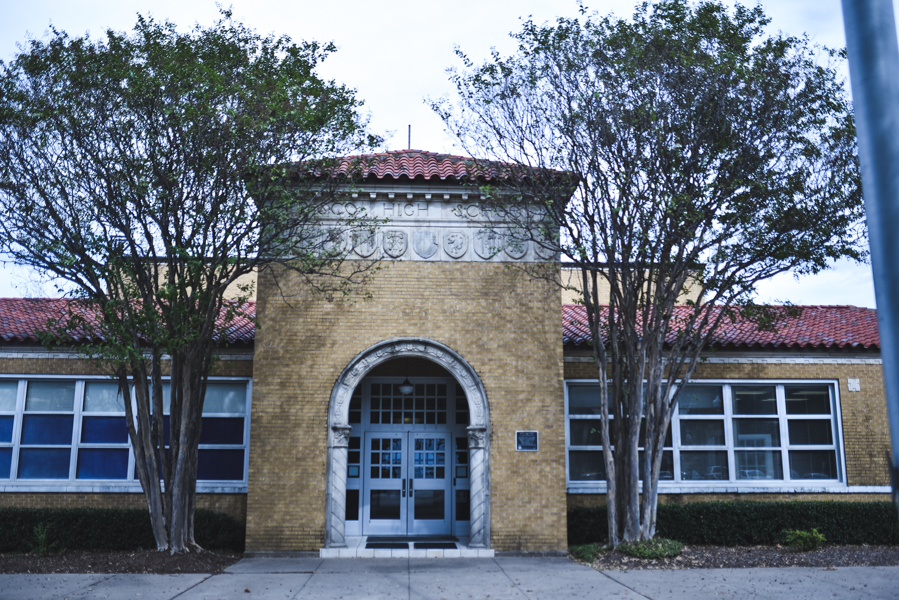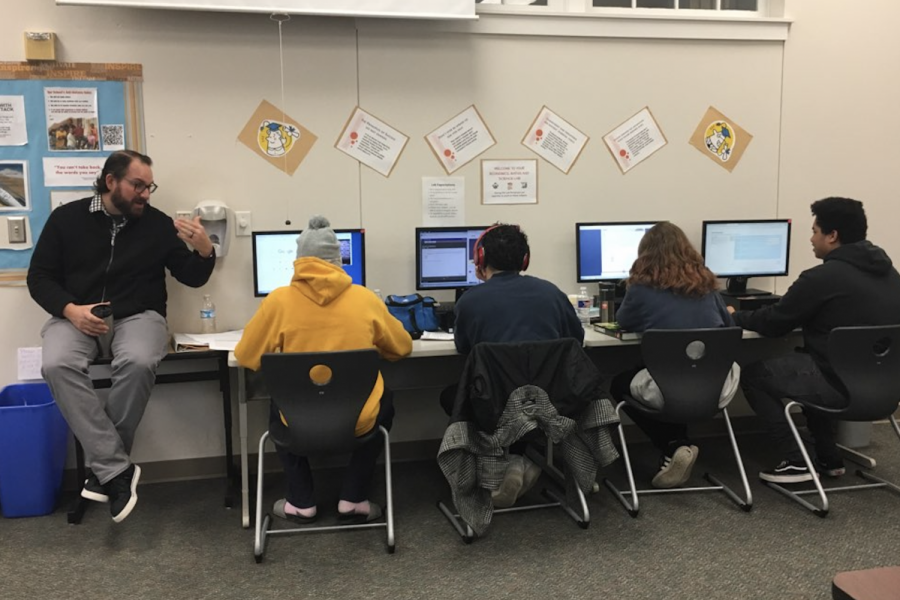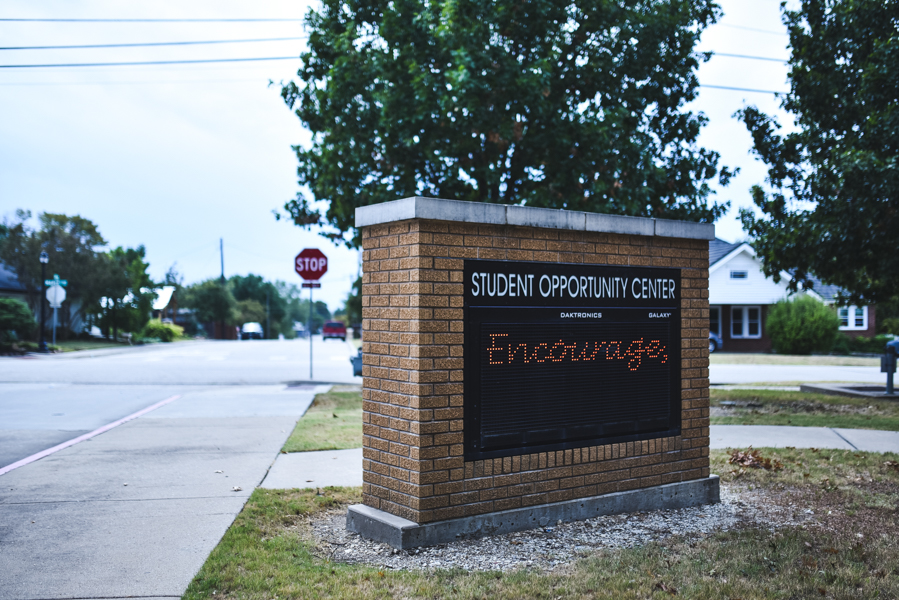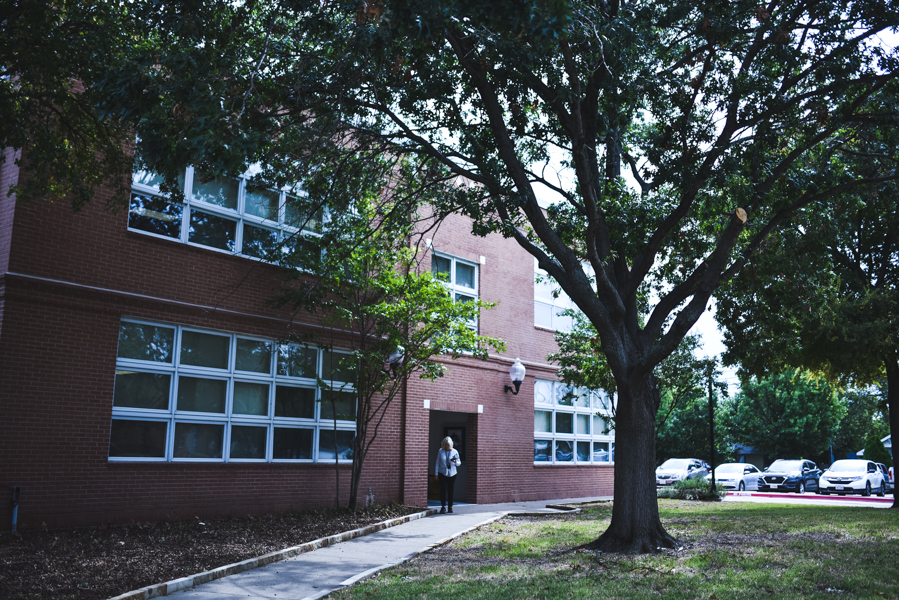Behind Closed Doors: the Student Opportunity Center
October 16, 2019
What started out as the only school in Frisco in 1939 now serves as the Frisco ISD’s Student Opportunity Center (SOC). In this four-part special report, Wingspan explores the history of the building that is now the SOC and takes a look at what life is like for students and teachers at the SOC and how the campus operates.
For more than 100 years, Frisco Independent School District has had a presence on Maple Street in downtown. It began as the original site of Frisco High School, and over the years has undergone several stages of construction and renovation. In 1937, the three story building on Maple Street was demolished with the current building constructed and serving as Frisco High School until 1973. In 1997, the building was renovated once again and made the Student Opportunity Center.
Chapter 1: A history and an overview
In 1939, a single story mission style school was built on Maple Street serving all grade levels, replacing Frisco’s single three-story school. The Depression era public works project continues to serve all grade levels to this day.
We do the drug and alcohol program [for students who need it]. We also have a social, emotional learning teacher that works with students and does lessons.
— former SOC principal Sue Kirk
Students in the district attend the SOC for a multitude of reasons, including, but not limited to: behavioral issues, failing classes, or struggling with the environment on other campuses. Former SOC principal Sue Kirk explains that there is not just one specific reason for students to study at the SOC.
“We have students over here that just haven’t made good choices and didn’t do the work they were supposed to and they’ve gotten behind,” Kirk said. “We’ve got students that maybe have been in the hospital and gotten behind for that reason. We’ve got students here that maybe came in from another state and the requirements were so different that when they got here as a senior, they needed a lot more credits than what the campus could get them to graduate on time. We’ve got students here that are really kind of school-phobic, you know, large crowds, for example, are hard on them, so we can bring them over here.”
The SOC consists of two programs. At the Academic Academy, students who are behind on credits have a program to catch up on the path to graduation. The discipline alternative education program (DAEP) is for students at the SOC for repeated violations of the Student Code of Conduct. Within this program the PAC program targets 9-12 graders and the KEYS program targets grades 1-8.
Although the SOC is not a traditional high school campus, the center adapts school concepts familiar to students in a way that allows students to excel.
“At lunches as long as the students are behaving, they can talk quietly, just like you can on a regular campus,” Kirk said. “We feel like that’s when we give them a break. In the afternoon the students have their advisory period. We do the drug and alcohol program [for students who need it]. We also have a social, emotional learning teacher that works with students and does lessons. We do all types of lessons with the students during the advisory period.”
The SOC places an emphasis on individual learning as class settings have a ratio of about eight to nine students to one teacher.
“In fact, more times than not the students’ academics are even better over here, because we do have such small classes,” Kirk said. “By law, you have to have a ratio of no more than 10 to one. Having 10 students in a classroom with a teacher is a lot different than having 25 or 30 students in a classroom, so the teachers can check in a lot quicker. They can see the students not understanding something; it’s just a lot easier when you’ve got small classes like that.”
Math teacher Mark Matthews instructs students while they are working on coursework at the Academic Academy. The SOC has typically about 150 students enrolled in the program at any time.
Chapter 2: the Academic Academy
In April 2019, 148 students were enrolled in the Academic Academy, all working to get caught up on credits.
“Under that program, we take 9 through 12 grades students,” former SOC principal Sue Kirk said. “We first, of course, make sure we get our 12th grade students in, because the whole thing is, the main focus of that program is if students are behind in credits, then we’re to get them over here, so they can graduate on time, or as near on time, as possible. If a student goes into their senior year, and needs 12 credits to graduate, they can’t get those 12 credits on a campus so we accelerate. Our curriculum is accelerated in the Academic Academy.”
If a student goes into their senior year, and needs 12 credits to graduate, they can’t get those 12 credits on a campus so we accelerate.
— former SOC principal Sue Kirk
Freshmen students that have failed classes in the first semester now have the chance to end the year with all their credits via the ninth grade academy.
“Let’s say they failed either three to four of their core classes,” Kirk said. “We get them over here, we get those first semester credits made up within the first six weeks that they’re over here, and then we do their second semester ninth grade courses. The goal of that part of the program is to have those students have enough credits stand to be 10th graders next year, because if they stay on their home campus, the chances of them being 10 graders if they failed everything first semester, are very slim. We’re trying to help them accelerate on the front end so they don’t end up as a senior behind in credit.”
Although some students fall behind as a result of moving to Frisco, new students from elsewhere in Texas and even across the world can catch up with the credit recovery program.
“I am originally not from here,” former Centennial High School student Joy Mwatha said. “I’m from Africa and when I came here, I missed half of my freshman year, so I was way behind on credits so I was recommended to come here to the SOC in order to catch up on my credits.”
The SOC uses blended learning in order to help accelerate the students. One of the methods is to use Edgenuity which includes credit recovery courses designed to help students who have fallen behind to focus on exactly the skills they need to so they can graduate on time.
“We use that program, but our teachers also do a more blended piece than what they do on the campuses,” Kirk said. “On the campuses if they’re in credit recovery, they pretty much just get put in that online class and the student just works on it. Here, our teachers may use parts of Edgenuity, and then they may supplement it with their own work to do, but basically, the program is streamlined, so the classes are streamlined.”
For students like Mwatha, the credit recovery program helped in stimulating progress.
When I came here, I kicked into full gear. I was doing my work. I even got to the end of the month on time.
— former student Joy Mwatha
“It has impacted me because when I came here, I never used to do my work at all,” Mwatha said. “When I came here, I kicked into full gear. I was doing my work. I even got to the end of the month on time. So yeah, like, it just affected me to work super hard.”
The SOC also utilizes instructional coaches in the building that serve multiple roles such as teaching, helping other teachers with classroom and academic situations, and bringing information from the district to the teachers.
“The main thing we make sure is that all the subject areas are hitting the TEKS, that’s our number one,” math teacher Mark Matthews said. “Not only the TEKS, but also our main goal applies for each subject area and each one is different. We have head teachers for each subject area that kind of touch in with them and see what they’re doing and what they need, and make sure that those kids are following the same guidelines as what is on the normal campus.”
The Disciplinary program serves students of all grade levels. In this chapter Wingspan takes a look at the program for high school students
Chapter 3: the disciplinary program
The disciplinary program was designed to be broken up into two placements: mandatory and discretionary.
“There’s what’s called mandatory, and this is where like if a student is caught on drugs or if they’re in possession of drugs on campus, or there are assaults,” Kirk said. “Mainly ours are drugs and alcohol, but there are other reasons why that the students can be sent over here. We have a 60 day placement with a 30 day review and students just have to jump through certain hoops. We have a point sheet that they have to carry around with them so their behavior has to be, not perfect, but good, and they have to be passing all their classes.”
Depending on the placement, the SOC has also parent programs to help students get back on track.
“If they are here for a drug or alcohol placement, then they have classes during the day that the students have to attend that are drug and alcohol related,” Kirk said. “The parents have to come for a night-parent class on drug and alcohol for them to go back on the 30 day review, otherwise, students will have to stay for the full placement.”
However, not all students are part of the disciplinary program because of illegal activities.
“The other type of placements that are in a discipline program are called discretionary and this is for students that just have continuously done some things,” Kirk said. “You know, you’ve seen the kiddos that are just, class clowns; they don’t do what they’re supposed to after so many strikes. The students and the campuses have worked with them and their behavior hasn’t changed. They’re not being successful on the campus so they end up coming over here on what’s called a discretionary placement.”
The program enforces discipline in similar ways to other campuses, but Kirk explains that the SOC has a unique point system.
“We still have In school,” Kirk said. “We have OSS. The difference is that they carry a point sheet with them and every period the teacher has to give them some. They have to earn so many points during the day and once they earn those points, then they keep going up on levels and they go through the red level, the yellow level, and in the green level.
In order to go back to their home campus, students are required to be on the green level for 10 days, the yellow level for 3 days, the red level for 3 days, and then be on the green level for the rest of the 30 day review.
“The teacher has those points sheets up there and if a student talks out, or doesn’t follow a directive the teacher gives them, then they will take them reduce their points for the day,” Kirk said. “If they get so many points reduced, then they have to go back to a lower level and at some point they’ll end up back in red room or ISIS, which is basically the same thing. And then they have to start all over, which means then more than likely, they’re not going to be able to go back to their home campus after 30 Day Review.”
The SOC can be a short term solution for some students but it can be the final path to graduation for others. “Some students just really bond with our staff here and they feel that this is their campus so we have what we call celebrations,” former principal Sue Kirk said.
Chapter 4: celebration
As students finish up programs at their own pace, the SOC has two celebrations a year for graduating students rather than a traditional ceremony.
“Our students are allowed to go through graduation with their home campus if they want to, but since they’re finishing up at all different times of the year, a lot of students are either already somewhere else, they may have moved, or they may already be working, so being able to get to their graduation is not always easy for us,” Kirk said. “Plus, some students really bond with our staff here and they feel that this is their campus so we have what we call celebrations.”
With a small student body and a teacher to student ratio of roughly 1:8, graduation at the SOC is a very personal celebration.
“Students can wear their gowns and we have the traditional march,” Kirk said. “The special part about our graduations, our celebrations, is that because we are so small, our teachers really get to know our students, so each student is called up to the podium and a teacher comes up and speaks on that student’s behalf. Teachers talk a little bit about what they were like as a student, what their plans are, and what their challenges were.”
Because we are so small, our teachers really get to know our students, so each student is called up to the podium and a teacher comes up and speaks on that student’s behalf.
— former SOC principal Sue Kirk
Unlike a normal campus, students at the SOC can stay until they’re 20 years old.
“You have to understand it’s pretty much 100 percent at risk students here,” Matthews said. “So as opposed to a normal campus, every kid here has something going against them. Whether it’s falling behind in academics, whether they’ve been hospitalized for a year and they have to catch up and get here, whether the girl is in pregnancy, having the different programs here has made it so that you see different levels of kids. We have a range of age: 14 years old to possibly 20 years old here. The dynamic of the different ages and what those kids bring in, allow us as teachers to delve into different levels of understanding of the students.”
According to Matthews, a lot of people in the district don’t understand what goes on, in regard to either the students or the teachers.
“They think that the kids come here and get a free ride is a big thing. That they’ve come in here, they’re here for a few years, and then they graduate out,” Matthews said. “They don’t realize that these kids are on a deadline, a three week deadline or a six week deadline to get a course done, which is very fast for kids. We have three different programs going on here that we have to adjust to, so we’re here from 8:00 in the morning until 4:30 in the afternoon. Not a lot of teachers are doing that. Some of us stay even later with kids than that.”
With this type of work, Matthews suggests that the unique structure at the SOC allows teachers like himself to connect in ways that aren’t possible at the high schools.
It’s tough on us sometimes, because we are so involved with the kids themselves, that we take their emotions with us. — SOC math teacher Mark Matthews
“It’s tough on us sometimes, because we are so involved with the kids themselves, that we take their emotions with us,” Matthews said. “We try to leave it here at the door when we leave out but it doesn’t happen. We know, because of the size of the school, we have about a hundred kids here compared to 2400. We know everything that’s going on. The kids don’t realize that and they wonder how we know that. Well, we talk. We have the same kids and we’re in the same labs together.”
While students might be at the SOC for a multitude of reasons, Kirk believes that finding the right teachers is paramount to students’ success.
“We always try to make sure that the type of teachers we hire here are teachers that can form those close relationships,” Kirk said. “They can look at a person as more than just what they see on the surface. It’s not just about teaching math, it’s about teaching the students and knowing their needs and working with that student on those things.”




